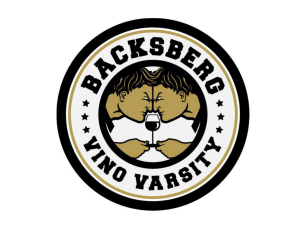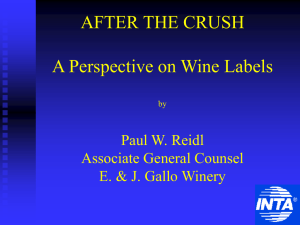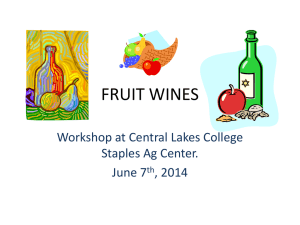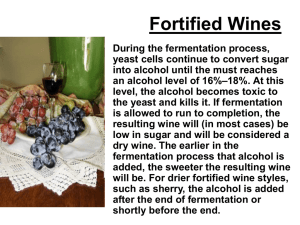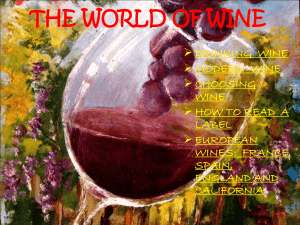ppt
advertisement
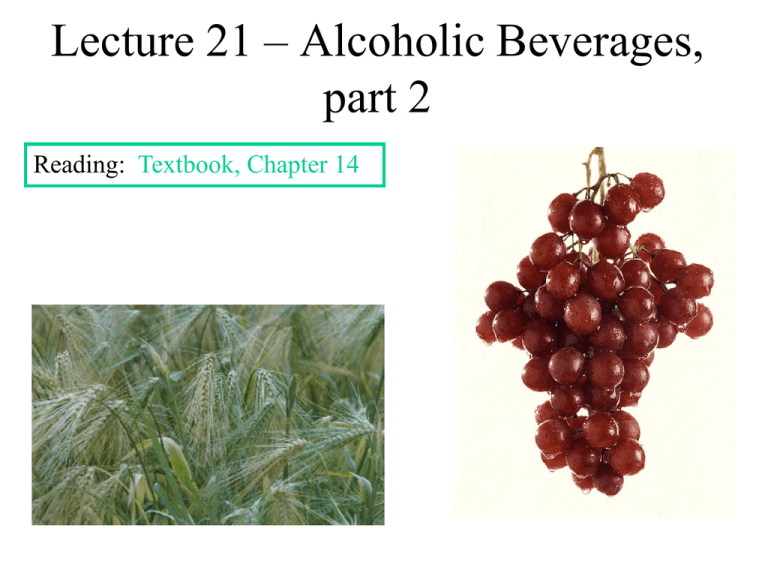
Lecture 21 – Alcoholic Beverages, part 2 Reading: Textbook, Chapter 14 Wine Grape (Vitis vinifera) – dominant fruit juice used for wine Original domestication – Asia, ca. 4000 BC - yeast present naturally on outside of fruit - fruit pressed to yield juice - sulfur dioxide (SO2) added to kill bacteria Types of Wine White wine – skins removed immediately after pressing; fermentation at 10-15 C (cool) Types of Wine White wine – skins removed immediately after pressing; fermentation at 10-15 C (cool) Red wine – skins not removed; red or purple grapes used fermentation at 25-30 C (warmer) Types of Wine White wine – skins removed immediately after pressing; fermentation at 10-15 C Red wine – skins not removed; red or purple grapes used fermentation at 25-30 C Rose wine – skins removed a short period after pressing fermentation at 25-30 C Types of Wine White wine – skins removed immediately after pressing; fermentation at 10-15 C Red wine – skins not removed; red or purple grapes used fermentation at 25-30 C Rose wine – skins removed a short period after pressing fermentation at 25-30 C Names of wine – based on variety of grape, or geographical location Types of Wine White wine – skins removed immediately after pressing; fermentation at 10-15 C Red wine – skins not removed; red or purple grapes used fermentation at 25-30 C Rose wine – skins removed a short period after pressing fermentation at 25-30 C Names of wine – based on variety of grape, or geographical location Vintage – year in which grapes were picked; growing conditions affect the amount of sugar and flavoring components that can produce variations in the quality of the wine Champagne Still Wines – carbon dioxide vented during fermentation, settling Sparkling Wines – made by second round of fermentation before bottling: Champagne Still Wines – carbon dioxide vented during fermentation, settling Sparkling Wines – made by second round of fermentation before bottling: - sugar + specially selected yeasts added to still wine Champagne Still Wines – carbon dioxide vented during fermentation, settling Sparkling Wines – made by second round of fermentation before bottling: - sugar + specially selected yeasts added to still wine - problem: removal of sediment formed from yeast (bottles stored with neck at downward angle and turned; sediment decanted before final corking) Champagne Still Wines – carbon dioxide vented during fermentation, settling Sparkling Wines – made by second round of fermentation before bottling: - sugar + specially selected yeasts added to still wine - problem: removal of sediment formed from yeast (bottles stored with neck at downward angle and turned; sediment decanted before final corking) Champagne – sparkling wine produced in area of La Champagne, France Inexpensive sparkling wine – carbonated like soda pop Champagne - Terms Quarter-Bottle 6.3 fluid ounces Level of Dryness Amount of residual sugar per liter Half-Bottle 12.7 fluid ounces Extra Brut, Brut Sauvage, Bottle 25.4 fluid ounces Ultra Brut, Brut Integral, Magnum 50.8 fluid ounces 2 bottles Brut Zero Jeroboam 101.6 fluid ounces 4 bottles Brut Rehoboam 147 fluid ounces 6 bottles Extra Dry, Extra Sec 1.2 to 2.0% Methuselah 196 fluid ounces 8 bottles Sec 1.7 to 3.5% Salmanazar 304.8 fluid ounces 12 bottles Demi-Sec 3.3 to 5.0% Balthazar 406.4 fluid ounces 16 bottles Doux (sweetest) 5% and up 508 fluid ounces 20 bottles Nebuchadnezzar .6% 1.5% Fortified Wines Fortified Wine: concentrated ethanol or distilled beverage added - sherry, port, Madeira (from specific regions) - Dubonnet, vermouth – flavorings added also Distilled Wine: - brandy – wine distilled, then aged (Cognac, Armagnac – regions of France) - other fruits may be used: calvados (apple); kirsch (cherry) - liqueur, cordial: sugars and flavors added to the distilled wine Distilled Wines Distilled Wine: distillation alcohol concentrated - brandy – wine distilled, then aged (Cognac, Armagnac – regions of France) France in Crisis – The Phylloxera Epidemic I. The Mystery Mid 1800s – wine industry in France – employed 1/3 of population; second largest export; accounted for 1/6 of government revenues France in Crisis – The Phylloxera Epidemic I. The Mystery Mid 1800s – wine industry in France – employed 1/3 of population; second largest export; accounted for 1/6 of government revenues 1860s – grape vines start mysteriously dying – suddenly turning brown, the leaves shriveling, the roots turning black France in Crisis – The Phylloxera Epidemic I. The Mystery Mid 1800s – wine industry in France – employed 1/3 of population; second largest export; accounted for 1/6 of government revenues 1860s – grape vines start mysteriously dying – suddenly turning brown, the leaves shriveling, the roots turning black The disease is first noticed in the southern part of the country. Northern growers scoffed at the problem – a hoax, or perhaps divine punishment for overproduction by greedy southerners France in Crisis – The Phylloxera Epidemic I. The Mystery Mid 1800s – wine industry in France – employed 1/3 of population; second largest export; accounted for 1/6 of government revenues 1860s – grape vines start mysteriously dying – suddenly turning brown, the leaves shriveling, the roots turning black The disease is first noticed in the southern part of the country. Northern growers scoffed at the problem – a hoax, or perhaps divine punishment for overproduction by greedy southerners Then the disease spreads inexorably across the nation France in Crisis – The Phylloxera Epidemic II. The Response No Immediately Apparent Cause Panic/Superstition - Place vials of holy water from Lourdes in the fields France in Crisis – The Phylloxera Epidemic II. The Response No Immediately Apparent Cause Panic/Superstition - Place vials of holy water from Lourdes in the fields - Bury live toads in blighted vineyards to draw out the poison France in Crisis – The Phylloxera Epidemic II. The Response No Immediately Apparent Cause Panic/Superstition - Place vials of holy water from Lourdes in the fields - Bury live toads in blighted vineyards to draw out the poison - Bring schoolboys twice a day to the fields to urinate on the vines France in Crisis – The Phylloxera Epidemic II. The Response No Immediately Apparent Cause Panic/Superstition - Place vials of holy water from Lourdes in the fields - Bury live toads in blighted vineyards to draw out the poison - Bring schoolboys twice a day to the fields to urinate on the vines Government offered a large cash prize for solution France in Crisis – The Phylloxera Epidemic III. The Salvation Government researchers – identified an aphid as the cause of the disease The phylloxera aphid attacks the roots (out of sight) and the aphids leave the plant when it starts to die France in Crisis – The Phylloxera Epidemic III. The Salvation Government researchers – identified an aphid as the cause of the disease The phylloxera aphid attacks the roots (out of sight) and the aphids leave the plant when it starts to die Aphid was accidentally introduced from North America on imported grapevines France in Crisis – The Phylloxera Epidemic III. The Salvation Government researchers – identified an aphid as the cause of the disease The phylloxera aphid attacks the roots (out of sight) and the aphids leave the plant when it starts to die Aphid was accidentally introduced from North America on imported grapevines Use of resistant North American rootstocks for grafting scions from named varieties provided the solution Student Presentations: Exotic Spices
